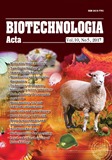ISSN 2410-7751 (Print)
ISSN 2410-776X (Online)

"Biotechnologia Acta" V. 10, No 5, 2017
https://doi.org/10.15407/biotech10.05.036
Р. 36-42 , Bibliography 9 , English
Universal Decimal Classification: 57.08:636:31
О. О. Тigunova 1, H. S. Аndriiash 1, N. Ye. Beiko 1, І. V. Melnyk 2, S. М. Shulga 1
1State organization “Institute of Food Biotechnology and Genomics” of the National Academy of Sciences of Ukraine, Kyiv
2National University of Food Technologies, Kyiv, Ukraine
The aim of the research was to investigate the accumulation of biobutanol by strains Clostridium acetobutylicum using alternative substrates (Jerusalem artichoke juice, technical glycerol, crude glycerol, shredded biomass of soy, rape, wheat and switchgrass). In order to increase the accumulation of butanol in the process of cultivation, the cells of C. acetobutylicum were statically immobilized on carriers (belting strips, ferrite rings and Raschig rings) by the method of adsorption immobilization. The cells were precipitated by centrifugation, the supernatant was distilled and then fermentation products were determined. Gas chromatography was used to determine the presence of solvents in the culture fluid. The biggest accumulation of butanol (2 g/dm3) was at concentration of crude glycerol 16 g/dm3 in the medium, and complete inhibition of culture development — at glycerol concentration 25 g/dm3. The accumulation of butanol by the strain C. acetobutylicum ІМВ В-7407 using fill and draw method depended on the amount of sequestered and infused medium. Immobilization of the culture using the Raschig rings allowed increasing the bioconversion to butanol twice. So it is shown the possibility to use non-traditional substrates for the production of biobutanol. The most accumulation of butanol was achieved using glycerol (11 g/dm3) as water-soluble substrate, and using switchgrass as lignocelluloses substrate (2,6 g/dm3). Immobilization of C. acetobutylicum culture cells on carriers increased the accumulation of butanol. The use of Raschig rings, as carriers for immobilization, allowed increasing the accumulation of butanol twice.
Key words: biobutanol, Clostridium acetobutylicum IMB B-7407, immobilization.
© Palladin Institute of Biochemistry of National Academy of Sciences of Ukraine, 2017
References
1. Jiang J., Wang P., Hou D The mechanism of cesium ions immobilization in the nanometer channel of calcium silicate hydrate: a molecular dynamics study. Phys.l Chem. Chem. Phys. 2017, 3–6. doi: 10.1039/c7cp05437h.
2. Zhuang W., Liu X., Yang J., Wu J., Zhou J., Chen Y., Liu D., Ying H. Immobilization of Clostridium acetobutylicum onto natural textiles and its fermentation properties. Microb. Biotechnol. 2017, 10(2), 6–8. doi:10.1111/1751-7915.12557.
3. Yang Y., Hoogewind A., Moon Y. H., Day D. Production of butanol and isopropanol with an immobilized Clostridium. Bioprocess Biosyst. Eng. 2016, 39(3), 2–4. doi: 10.1007/s00449-
015-1525-1.
4. Tigunova O. O., Beiko V. YE, Andriash H. S., Pryiomov S. H, Shulga S. M. Domestic butanol-producing strains of the Clostridium genus. Biotechnol. асtа. 2017, 10(1), 34–42. doi:10.15407/biotech10.01.034
5. Jim?nez-Bonilla P., Wang Y. In situ biobutanol recovery from clostridial fermentations: a critical review. Crit.Rev. Biotechnol. 2017, 14(1), 4–6. doi:10.1080/07388551.2017.1376308.
6. Xue C., Zhao J., Chen L., Yang S. T., Bai F. Recent advances and state-of-the-art strategies in strain and process engineering for biobutanol production by Clostridium acetobutylicum. Biotechnol. Adv. 2017, 244 (1), 575–579. doi: 10.1016/j.biortech.2017.08.002.
7. Xin F., Chen T., Jiang Y., Lu J., Dong W., Zhang W., Ma J., Zhang M., Jiang M. Enhanced biobutanol production with high yield from crude glycerol by acetone uncoupled Clostridium sp. strain CT7. Biores. Technol. 2017, 244(1), 9–11. doi: 10.1016/j.biortech.2017.08.002.
8. Liu D., Chen Y., Li A., Ding F., Zhou T., He Y., Li B., Niu H., Lin X., Xie J., Chen X., Wu J., Ying H. Enhanced butanol production by modulation of electron flow in Clostridium acetobutylicum B3 immobilized by surface adsorption. Biores. Technol. 2013, 25(2), 322–232. doi: 10.1016/j.biortech.2012.11.090.
9. Nazaro O. A., Korneeva O. S. Helianthus tuberosus as a prospective materials in organic solvents biotechnology. Aktualnaya Biotekhnologiya. 2013, 1(4), 33–37. (In Russian).

